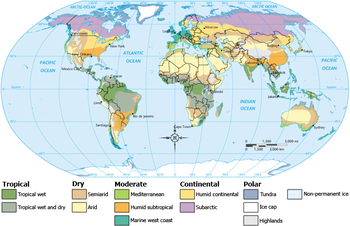- Climate of Missouri
-
Missouri generally has a humid continental climate (Köppen climate classification Dfa), with cool to cold winters and long, hot summers. In the southern part of the state, particularly in the Bootheel, the climate borders on a humid subtropical climate (Köppen Cfa). Due to its location in the interior United States, Missouri often experiences extremes in temperatures. Not having either large mountains or oceans nearby to moderate its temperature, its climate is alternately influenced by air from the cold Arctic and the hot and humid Gulf of Mexico.
Contents
Overview
mean temperatures and precipitations from 1895–2003 Month Precipitation Temp. Jan 2.1 in 29.8 °F Feb 2.0 in 33.8 °F March 3.3 in 43.5 °F April 4.0 in 54.6 °F May 4.8 in 64.2 °F June 4.65 in 73 °F July 3.8 in 77.6 °F Aug 3.7 in 76 °F Sep 4.0 in 68.3 °F Oct 3.2 in 57.1 °F Nov 2.9 in 44 °F Dec 2.4 in 33.3 °F While the table to the right would suggest a very mild climate one has to consider that a temperature fluctuation of 20 degrees Fahrenheit on average and 30 to 40 degrees Fahrenheit (17 to 22 degrees Celsius) in a twenty four hour period is common. The mean temperature should not be used in discussions regarding the climate of Missouri. Although the mean temperature for June and July is only 73 °F and 76 °F (23 °C and 24 °C) it is not uncommon for the temperature to reach 100 °F (38 °C) at least 3 concurrent days each week in these months, as it did in 1904 during the World Fair where the temperature in St. Louis, Missouri was 103 °F (39 °C).
Monthly Normal High and Low Temperatures For Various Missouri Cities City Jan Feb Mar Apr May Jun Jul Aug Sep Oct Nov Dec Columbia 37/18 44/23 55/33 66/43 75/53 84/62 89/66 87/64 79/55 68/44 53/33 42/22 Kansas City 36/18 43/23 54/33 65/44 75/54 84/63 89/68 87/66 79/57 68/46 52/33 40/22 Springfield 42/22 48/26 58/35 68/44 76/53 85/62 90/67 90/66 81/57 71/46 56/35 46/26 St. Louis 38/21 44/26 55/36 67/46 76/57 85/66 90/71 88/69 80/60 68/48 54/37 42/26 [1] Spring
Spring, March through May, is generally the wettest season of the year with the mean temperature from 1895 until 2003 being about 12°C (54°F) and its mean precipitation (in the form of rain) for this period being approximately 300 mm (12 inches). The spring rains often continue through June. The spring also produces the most tornadoes; with an average of 35 tornadoes each year.
Summer
Summer, June through August, is the hottest time of the year with a mean temperature of 24°C (75 °F, 24 °C) and a mean precipitation of 300 mm (12 inches) with June having more precipitation than either July or August. The extreme highs for the year often occur in July or August. Tropical cyclones and their remains can impact the state during this time of the year, contributing to area rainfall.
Fall
Fall, September through November, has less and less precipitation towards the end of the season. The mean temperatures for this season are 13.6°C (56.5°F) and the mean precipitation is 250mm (10 in). Tropical cyclones and their remains can impact the state into October, contributing to area rainfall.
Winter
Winters in Missouri can be long with temperatures ranging from mildly to bitterly cold. Kansas City's average January low is 26 °F (−3 °C) and St. Louis's average January low is 29 °F (−2 °C). The coldest temperature ever recorded in Missouri was −40 °F (−40 °C), set at Warsaw on 13 February 1905. Winter also tends to be the driest season, but typically yields significant amounts of winter precipitation. Snowfall averages 20 inches (51 cm) in the state's northern region, and 10 inches (25 cm) in the southeast. During the winter, northwest winds prevail; the air movement is largely from the south and southeast during the rest of the year.[2]
See also
- Climate
- Climatology
- List of wettest known tropical cyclones, and their remnants, across Missouri
- St. Louis tornado history
References
Climate of the United States States - Alabama
- Alaska
- Arizona
- Arkansas
- California
- Colorado
- Connecticut
- Delaware
- Florida
- Georgia
- Hawaii
- Idaho
- Illinois
- Indiana
- Iowa
- Kansas
- Kentucky
- Louisiana
- Maine
- Maryland
- Massachusetts
- Michigan
- Minnesota
- Mississippi
- Missouri
- Montana
- Nebraska
- Nevada
- New Hampshire
- New Jersey
- New Mexico
- New York
- North Carolina
- North Dakota
- Ohio
- Oklahoma
- Oregon
- Pennsylvania
- Rhode Island
- South Carolina
- South Dakota
- Tennessee
- Texas
- Utah
- Vermont
- Virginia
- Washington
- West Virginia
- Wisconsin
- Wyoming
Federal district Insular areas - American Samoa
- Guam
- Northern Mariana Islands
- Puerto Rico
- U.S. Virgin Islands
Categories:
Wikimedia Foundation. 2010.

